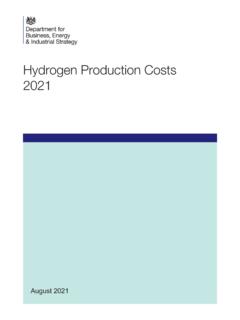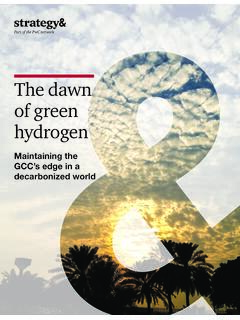Transcription of Summary of Electrolytic Hydrogen Production
1 September 2004 NREL/MP-560-36734 Summary of Electrolytic Hydrogen Production Milestone Completion Report Johanna Ivy National Renewable Energy Laboratory1617 Cole Boulevard, Golden, Colorado 80401-3393 303-275-3000 Operated for the Department of Energy Office of Energy Efficiency and Renewable Energy by Midwest Research Institute Battelle Contract No. DE-AC36-99-GO10337 NOTICE This report was prepared as an account of work sponsored by an agency of the United States government. Neither the United States government nor any agency thereof, nor any of their employees, makes any warranty, express or implied, or assumes any legal liability or responsibility for the accuracy, completeness, or usefulness of any information, apparatus, product, or process disclosed, or represents that its use would not infringe privately owned rights.
2 Reference herein to any specific commercial product, process, or service by trade name, trademark, manufacturer, or otherwise does not necessarily constitute or imply its endorsement, recommendation, or favoring by the United States government or any agency thereof. The views and opinions of authors expressed herein do not necessarily state or reflect those of the United States government or any agency thereof. Available electronically at gov/bridge Available for a processing fee to Department of Energy and its contractors, in paper, from: Department of Energy Office of Scientific and Technical Information Box 62 Oak Ridge, TN 37831-0062 phone: fax: email: Available for sale to the public, in paper, from: Department of Commerce National Technical Information Service 5285 Port Royal Road Springfield, VA 22161 phone: fax: email: online ordering.
3 Printed on paper containing at least 50% wastepaper, including 20% postconsumer waste Executive Summary This report provides a technical and economic overview of the Electrolytic Hydrogen Production systems commercially available as of December 2003. The technical analysis focuses on five companies electrolysis units: Stuart IMET; Teledyne HM and EC; Proton HOGEN; Norsk Hydro HPE and Atmospheric; and Avalence Hydrofiller. Cost information was obtained for three different systems, and the economics of these processes were analyzed. The technical analysis found that currently, the largest electrolyzer unit sold produces only 380,000 kg H2/year.
4 There are two limitations for electrolyzers of this size. If the system were to be used for forecourt Production , fueling approximately 1,900 cars, MW of electricity would be required. This electricity demand would likely preclude the purchase of cheaper industrial electricity in the forecourt scenario, thus raising the price of Hydrogen . If the system were to be used in a large Hydrogen generation plant, the limited Hydrogen Production capacity means that a significant number of electrolyzer units would be required. For example, a 500,000 kg/day Hydrogen generation plant using nuclear power and electrolysis would require 500 of the largest electrolyzer units available today.
5 In this scenario, electrolyzers 10 to 100 times the size of today s units could be utilized. An initial cost boundary analysis was completed to determine the effects of electricity price on Hydrogen costs. For each electrolyzer, the specific system energy requirement was used to determine how much electricity is needed to produce Hydrogen ; no capital, operating or maintenance costs are included in the calculation. At current electrolyzer efficiencies, in order to produce Hydrogen at lower than $ , electricity costs must be lower than 4 and cents per kWh. For an ideal system operating at 100% efficiency, electricity costs must be less then cents per kWh to produce Hydrogen at lower than $ This analysis demonstrates that regardless of any additional cost elements, electricity costs will be a major price contributor.
6 The detailed economic analyses are based on three distinct systems for which cost and economic data were available. These data may or may not be representative of the costs and systems within each category. These three systems represent a small neighborhood (~20 kg/day), a small forecourt (~100 kg/day), and a forecourt size (~1000 kg/day). In this analysis, the Hydrogen selling prices were $ H2 for the small neighborhood size, $ H2 for the small forecourt size, and $ H2 for the forecourt size. The analysis was performed using year 2000 dollars, which were escalated to 2005 dollars.
7 For the forecourt case, electricity represents 58% of the cost of the Hydrogen , and the capital costs only 32%. For the small forecourt case, the electricity contribution drops to 35% while the capital costs become the major cost factor at 55%. In the neighborhood case, the capital costs increase to 73%, but electricity costs are not insignificant at 17%. This analysis demonstrated that for all systems electricity price is a contributor to Hydrogen price, but for small-sized electrolyzers, capital costs are more significant. 1 Introduction The purpose of this report is to give an overview of the current state of Electrolytic Hydrogen Production technologies, and to provide an economic analysis of the processes.
8 The study focuses on five companies current electrolyzer lines: Stuart IMET; Teledyne HM and EC; Proton HOGEN; Norsk Hydro HPE and Atmospheric; and Avalence Hydrofiller. The report details the state of technology as of December 2003 for all five companies electrolysis units, and then analyzes the economics of three standard sized electrolysis processes. Analysis Methodology The technical details for each company s electrolysis systems were obtained from research on the Internet, and from personal conversations with industry representatives. The data presented are representative of systems available in December 2003.
9 A detailed Summary of each electrolysis model included in this study can be found in Appendix A. For purposes of the analysis, the available electrolysis systems were categorized into five different size ranges: home, small neighborhood, neighborhood, small forecourt and forecourt. The term forecourt refers to a refueling station. The number of cars served and Hydrogen Production rate for each size are as follows: The home size will serve the fuel needs of 1- 5 cars with a Hydrogen Production rate of 200-1000 kg H2/year. The small neighborhood size will serve the fuel needs of 5-50 cars with a Hydrogen Production rate of 1000-10,000 kg H2/year.
10 The neighborhood size will serve the fuel needs of 50-150 cars with a Hydrogen Production rate of 10,000 30,000 kg H2/year. The small forecourt size, which could be a single Hydrogen pump at an existing station, will serve 150 500 cars with a Hydrogen Production rate of 30,000 100,000 kg H2/year. A full Hydrogen forecourt will serve more then 500 cars per year with a Hydrogen Production rate of greater then 100,000 kg H2/year. The number of cars served was determined by calculating that a car requires approximately 200 kg of Hydrogen per year. This 200 kg requirement assumes that on average a car travels 12,000 miles per year, and that a vehicle will travel 60 miles/kg of Hydrogen .














